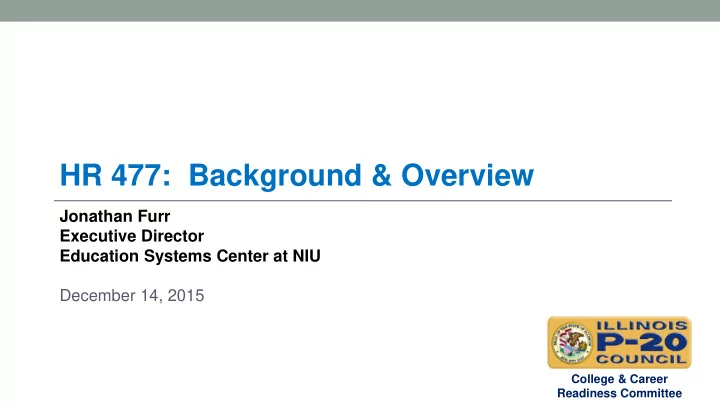

HR 477: Background & Overview Jonathan Furr Executive Director Education Systems Center at NIU December 14, 2015 College & Career Readiness Committee
2 Background on P- 20 Council’s Postsecondary & Workforce Readiness Focus • Postsecondary & Workforce Readiness (PWR) Steering Committee: Joint committee of Subcommittee on College & Career Readiness and Subcommittee on Data, Assessment, and Accountability • PWR Committee met monthly or bi-monthly from May 2012 through July 2013 • Used interim surveys to address issues not fully flushed out in meetings • Developed a college & career readiness framework and outlined key success factors
3 Key Success Factors Personalized Learning Plans: All students should develop a personalized learning plan 1. in middle school that help guide them through high school and postsecondary to career Placement & Early College Credit: Ensure that expectations for students are consistent 2. across high school and postsecondary and increase opportunities for students to earn college credit in high school High School Graduation Requirements & Support: Ensure high school graduation 3. signifies readiness for college and career and provide support so students stay “on track” to graduate Work-based Learning; Illinois Pathways: All students from middle school on should 4. have career exploration and work-based learning options; Illinois Pathways can provide a structure for continued support to local efforts to align education and career opportunities
4 HB 3196 • Filed 2/15; Postsecondary and Workforce Readiness Act (Chapa LaVia) • Resulted from over one year of meetings with state agency leadership in the context of the Postsecondary and Workforce Readiness Report • 5 overarching policy components as described on subsequent slide
5 HB 3196 Policy Components New Illinois graduation requirements: Implementing new high school graduation 1. requirements that are based on student demonstration of competencies aligned with the new Illinois Learning standards. Student readiness for college- level instruction (“Catch - up”): Ensuring students have 2. access to supports and instruction in the senior year of high school to avoid remediation. Early college credit (“Speed - up”): Expanding opportunities for students to access college- 3. level instruction prior to high school graduation. Career pathway endorsements: Establishing career pathway endorsements on high school 4. diplomas relating to prioritized industry sectors, as well as ensuring student access to pathway opportunities in high school and postsecondary education. Awareness, advising, and planning for college and careers: Supporting students and 5. families to understand college and career opportunities and expectations, as well as systems to support access to postsecondary education.
6 Redefining the High School to College Transition • 5-month planning process supported by Joyce Foundation and College Board to address the high school to postsecondary transition in Illinois • Process involved 9 regional teams, state education agencies, and national experts • Outcomes: Network of regions from across Illinois with impressive practices in place or emerging Framework for aligning high school and postsecondary education systems to support student success ilhstocollege.org
9 th through 13+ Student-facing Systems 1. Core Academic Systems (“Catch - up”) 2. Planning and Transition Supports 3 . Accelerated Learning (“Speed - up”) All of the elements of the framework should be addressed in successful high school to postsecondary transition systems 7
8 HR 477 • Identified aspects of the PWR policy agenda where there was greater consensus for moving forward: Piloting competency-based high school grad requirements 1. Scaling of 12 th grade dev ed modelds 2. Qualifying high school teachers as dual credit instructors 3. Career pathway endorsements on high school diplomas 4. Education & career development & planning 5. • Adopted by Illinois House on May 30, 2015 • Generally, recommendations by February 1, 2016
9 Qualifying HS Teachers as Dual Credit Instructors • ICCB/Higher Learning Commission Requirements: For core academic (non- CTE), adjunct CC faculty must have master’s degree in the subject or 18 graduate credits in that subject • Challenges: High school teachers often have more general master’s – not in a subject area Higher ed not structuring programs conducive for high school teachers Insufficient cohorts for higher ed AP vs. dual credit High school teachers often not trained on issues associated with serving as an adjunct faculty
10 The Dual Credit Charge • Primary Charge: By June 30, 2016, ISBE, ICCB, IBHE, and ISAC, in consultation with appropriate stakeholders, enter into an IGA for the joint establishment of a program that will incentivize and accelerate the delivery of professional development and continuing education for high school teachers that will allow them to qualify as instructors for dual credit courses in high- need subject areas and locations within the State • Program Components: A common statewide application for high school teachers Commitments from teacher preparation providers to develop cohort models appropriate for high school teachers Other supports for accelerated higher education delivery models
11 Questions; Discussion ilhstocollege.org (House Resolution 477 Tab) Jonathan Furr jfurr@niu.edu
Recommend
More recommend